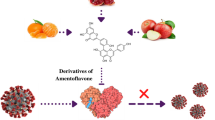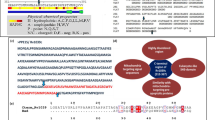Abstract
The studies into the pathophysiology of viral miRNAs are still in infancy; the interspecies regulation at the miRNA level fuels the spark of the investigation into the repertoire of virus–host interactions. Reports pertaining to the viral miRNAs role in modulating/evading the host immune response are surging up; we initiated this in silico study to speculate the role of human cytomegalovirus (HCMV)-encoded miRNAs on human antiviral mechanisms such as apoptosis and autophagy. The results indicate that both the above mechanisms were targeted by the HCMV miRNAs, located in the unique long region of the HCMV genome. The proapoptotic genes MOAP1, PHAP, and ERN1 are identified to be the potential targets for the miR-UL70-3p and UL148D, respectively. The ERN1 gene plays a role in the initiation of Endoplasmic reticulum stress-induced apoptosis as well as autophagosome formation. This study shows that HCMV employs its miRNA repertoire for countering the cellular apoptosis and autophagy, particularly the mitochondrial-dependent intrinsic pathway of apoptosis. In addition, the homology studies reveal no HCMV miRNA bears sequence homology with human miRNAs.





Similar content being viewed by others
References
Ambros V, Lee R, Feinbaum RL (1993) The C. elegans heterochronic gene Lin-4 encodes small RNAs with antisense complementarity to Lin-14″. Cell 75(5):843–845
Bartel DP (2004) Micro RNAs: genomics, biogenesis, mechanism, and function. Cell 116:281–297
Lu LF, Liston A (2009) Micro RNA in the immune system, MicroRNA as an immune system. Immunology 127:291–298
Pfeffer S, Zavolan M, Grasser FA, Chien M, Russo JJ, Ju J, John B, Enright AJ, Marks D, Sander C, Tuschil T (2004) Identification of virus-encoded micro RNAs. Sci 304(5671):734–736
Cullen BR (2006) Viruses and micro RNAs. Nat Genet 38:S25–S30
Stern-Ginossar N, Saleh N, Goldberg MD, Prichard M, Wolf DG, Mandelboim O (2009) Analysis of human cytomegalovirus-encoded micro RNAs activity during infection. Virology 83:10684–10693
Gottwein E, Cullen BR (2008) Viral and cellular micro RNAs as determinants of viral pathogenesis and immunity. Cell Host Microbe 3:375–387
Ghosh Z, Mallick B, Chakrabarti J (2009) Cellular versus viral micro RNAs in host—virus interaction. Nucleic Acid Res 37(4):1035–1048
Grey F, Hook L, Nelson J (2008) The functions of Herpesvirus encoded micro RNAs. Med Microb Immunol 197:261–267
Terhune S, Torgoi E, Moorman N, Silva M, Qian Z, Shenk T (2007) Human Cytomegalovirus UL38 protein blocks apoptosis. J Virol 81(7):3109–3123
Ahn K, Angulo A, Ghazal P, Peterson PA, Yang Y, Fruh K (1996) Human Cytomegalovirus inhibits antigen presentation by a sequential multistep process. Proc Natl Acad Sci USA 93:10990–10995
Wiertz EJ, Jones TR, Sun L, Bogyo M, Geuze HJ, Ploegh HL (1996) The human Cytomegalovirus US11 gene product dislocates MHC class I heavy chains from the endoplasmic reticulum to the cytosol. Cell 84:769–779
Hegde NR, Tomazin RA, Wisner TW, Dunn C, Boname JM, Lewinsohn DM (2002) Inhibition of HLA-DR assembly, transport, and loading by human cytomegalovirus glycoproteinus3: a novel mechanism for evading major histocompatibility complex class II antigen presentation. J Virol 76:10929–10941
Ahn K, Gruhler A, Galocha B, Jones TR, Wiertz EJ, Ploegh HL, Peterson PA, Yang Y, Fruh K (1997) The ER-luminal domain of the HCMV glycoprotein US6 inhibits peptide translocation by TAP. Immune 6(5):613–621
Loenen WA, Bruggeman CA, Wiertz EJ (2001) Immune evasion by human cytomegalovirus: lessons in immunology and cell biology. Semin Immunol 13:41–49
Maussang D, Verzijl D, Walsum MV, Leurs R, Holl J, Pleskoff O, Michel D, Dongen GAMS, Smit MJ (2006) Human cytomegalovirus-encoded chemokine receptor US28 promotes tumorigenesis. Proc Natl Acad Sci USA 103(35):13068–13073
Welte SA, Sinzger C, Lutz SZ, Singh-Jasuja H, Sampaio KL, Eknigk U, Rammensee HG, Steinle A (2003) Selective intracellular retention of virally induced NKG2D ligands by the human cytomegalovirus UL-16 glycoprotein. Eur J Immunol 33(1):194–203
Reyburn HT, Mandelboim O, Vales-Gomez M, Davis DM, Pazmany L, Strominger JL (1997) The class I MHC homologue of human cytomegalovirus inhibits attack by natural killer cells. Nature 386:514–517
Browne EP, Wing B, Coleman D, Shenk T (2001) Altered cellular mRNA levels in human cytomegalovirus infected fibroblasts: viral block to the accumulation of antiviral mRNAs. J Virol 75:12319–12330
Lockridge KM, Zhou SS, Kravitz RH, Johnson JL, Sawai ET, Blewett EL, Barry PA (2000) Primate cytomegaloviruses encode and express an IL-10-like protein. Virology 268(2):272–280
Wilkinson GW, Tomasec P, Stanton RJ, Armstrong M, Prod’homme V, Aicheler R, Mcshakky BP, Rickards CR, Cochane D, Lacey SL, Wang ECY, Griffin CA, Davison AJ (2008) Modulation of natural killer cells by human cytomegalovirus. J Clin Virol 41(3):206–212
Benedict CA, Butrovich KD, Lurain NS, Corbeil J, Rooney I, Schneider P, Tschopp J, Ware CF (1999) Cutting edge: a novel viral TNF receptor superfamily member in virulent strains of human cytomegalovirus. J Immunol 162:6967–6970
Penfold ME (1999) Cytomegalovirus encodes a potent alpha chemokine. Proc Natl Acad Sci USA 96(17):9839–9844
Huh YH, Kim YE, Kim ET, Park JJ, Song MJ, Zhu H, Hayward GS, Ahn JH (2008) Binding STAT2 by the acidic domain of human cytomegalovirus IE1 promotes viral growth and is negatively regulated by sumo. J Virol 82(21):10444–10454
Taylor RT, Bresnahan WA (2006) Human cytomegalovirus IE86 attenuates virus and tumor necrosis factor alpha-induced NF kappa β-dependent gene expression. J Virol 80:10763–10771
Goldmacher VS (2005) Cell death suppression by cytomegaloviruses. Apoptosis 10:251–265
Poncet D, Boya P, Larochette N, Jalil AA, Paulau AL, Cartron PF, Vallette FM, Schnebelen C, Bartel LM, Skaletskaya A, Boutolleau D, Martinou JC, Goldmatcher VS, Kroemer G, Zamazami N (2004) An anti-apoptotic viral protein that recruits bax to mitochondria. J Biol Chem 279(21):22605–22614
Yu Y, Alwine JC (2002) Human cytomegalovirus major immediate early proteins and simian virus 40 large T antigen can inhibit apoptosis through activation of the phosphatidylinositide 3′-OH kinase pathway and the cellular kinase AKT. J Virol 76:3731–3738
Chaumorcel M, Lussignol M, Mouna L, Carvigav Y, Fahie K, Cotte-Laffitte J, Geballe A, Brune W, Beau L, Codogno P, Esclatine A (2012) The human cytomegalovirus protein TRS1 inhibits via its interaction with beclin 1. J Virol 86:2571–2584
Spiller OB, Morgan BP, Tufaro F, Devine DV (1996) Altered expression of host encoded complement regulators on human cytomegalovirus infected cells. Eur J Immunol 26:1532–1538
Yu L, Leonardo MJ (2008) The selectivity of autophagy and its role in cell death and survival. Autophagy 4:567–573
Stern-Ginossar N, Elefant N, Zimmermann A, Wolf DG, Saleh N, Biton M, Horwitz E, Prokocimer Z, Prichard M, Hahn G, Goldman-Wohl D, Greenfield C, Yagel S, Hengel H, Altuvia Y, Marqalit H, Mandelboim O (2007) Host immune system gene targeting by a viral miRNA. Science 317(5836):376–381
Rehmsmeier M, Steffen P, Ho¨Chsmann M, Giegerich R (2004) Fast and effective prediction of micro RNA/target duplexes. RNA 10:1507–1517
Elefant N, Berger A, Shein H, Hofree M, Margalit H, Altuvia Y (2011) RepTar: a database of predicted cellular targets of host and viral miRNAs. Nucl Acids Res 1-7
Yan B, Zhao Jin-Liang (2012) mir-1228 prevents cellular apoptosis through targeting of Moap1. Apoptosis 17(7):717–724
Nair V, Zavolan M (2006) Virus encoded microRNAs; novel regulators of gene expression. Trends Microbiol 14:169–175
Gottwein E, Mukherjee N, Sachse C, Frenzel C, Majoros WH, Chi JTA, Braich R, Manoharan M, Soutschek J, Ohler U, Cullen BR (2007) A viral microRNA functions as an orthologue of cellular Mir-155. Nature 450:1096–1099
Skalsky RL, Samols MA, Plaisance KB, Boss IW, Riva A, Lopez MC, Baker HV, Renne R (2007) Kaposi’s sarcoma-associated herpesvirus encodes an ortholog of Mir-155. J Virol 81(123):12836–12845
Babu SG, Ponia SS, Kumar D, Saxena S (2011) Cellular oncomir orthologue in EBV oncogenesis. Comput Biol Med 10:891–898
Sullivan CS, Grundhoff AT, Tevethia S, Mpipas J, Ganem D (2005) SV40-encoded microRNAs regulate viral gene expression and susceptibility to cytotoxic T cells. Nature 435:682
Gupta A, Gartener JJ, Sethupathy P, Hatzigeorgiou AG, Fraser NW (2006) Anti-apoptotic function of a micro RNA encoded by the HSV-1 latency associated transcript. Nature 442:82–85
Murphy E, Vanicek J, Robins H, Shenk T, Levine AJ (2008) Suppression of immediate-early gene expression by herpes virus-coded micro RNAs: implications for latency. Proc Natl Acad Sci USA 105:5453–5458
Umbach JL, Kramer MF, Jurak I, Karnowski HW, Coen DM, Cullen BR (2008) Micro RNAs expressed by herpes simplex virus I during latent infection regulate viral mRNAs. Nature 454(7205):780–783
Tan KO, Tan KML, Chan SL, Yee KS, Bevort M, Ang KC, Yu VC (2001) Map-1, a novel proapototic protein containing a Bh3 like motif that associates with the Bax through its Bcl2 homology domains. J Biol Chem 276(4):2802–2807
Tan KO, Fu NY, Sukumaran SK, Chan SL, Kang JH, Chen BS, Yu VC (2005) Map-1, is a mitochondrial effector of bax. Proc Natl Acad Sci USA 50(41):14623–14628
Jiang X, Kim HE, Shu H, Zhao Y, Zhang H, Kofron J, Donnelly J, Burns D, Ng SC, Rosenberg S, Wang X (2003) Distinctive roles of PHAP proteins and prothymisine-alpha in a death regulatory path way. Science 299(5604):223–226
Garcia-Navas R, Munder M, Mollinedo F (2012) Depletion of l-arginine induces autophagy as a cytoprotective response to endoplasmic reticulum stress in human T lymphocytes. Autophagy 8(11):1557–1576
Tabas I, Ron D (2011) Integrating the mechanism of apoptosis induced by endoplasmic reticulum stress. Nat Cell Biol 13:184–190
Trobaugh DW, Gardner CL, Sun C, Haddow AD, Wang E, et al (2013) RNA viruses can hijack vertebrate microRNAs to suppress innate immunity. Nature doi:10.1038/12869
Acknowledgments
The authors are thankful to the Babasaheb Bhimrao Ambedkar University, Lucknow, India for providing the necessary infrastructural facilities.
Author information
Authors and Affiliations
Corresponding author
Rights and permissions
About this article
Cite this article
Babu, S.G., Pandeya, A., Verma, N. et al. Role of HCMV miR-UL70-3p and miR-UL148D in overcoming the cellular apoptosis. Mol Cell Biochem 393, 89–98 (2014). https://doi.org/10.1007/s11010-014-2049-8
Received:
Accepted:
Published:
Issue Date:
DOI: https://doi.org/10.1007/s11010-014-2049-8




